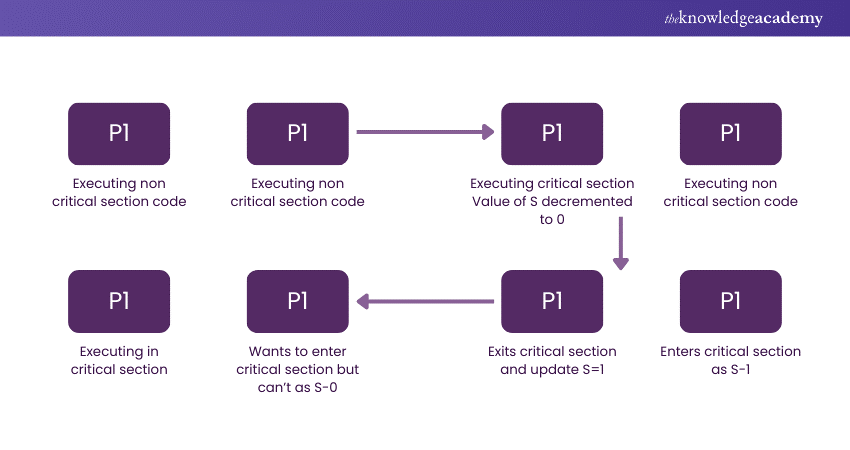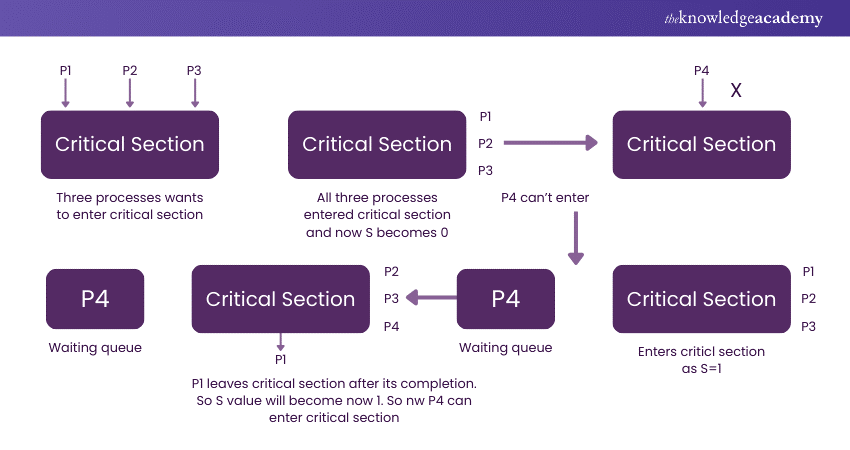We may not have the course you’re looking for. If you enquire or give us a call on 44 1344 203 999 and speak to our training experts, we may still be able to help with your training requirements.
We ensure quality, budget-alignment, and timely delivery by our expert instructors.

Imagine a busy intersection where traffic lights keep everything running smoothly without a hint of chaos! In the world of Operating Systems (OS), semaphores play a similar role, orchestrating the flow of processes to oversee orderly access to shared resources by preventing collisions and deadlocks. This blog explores What is Semaphore in OS, how they operate, how they are implemented, and more! Read on and learn why these tools are crucial for maintaining harmony in the digital landscape!
Table of Contents
1) What is a Semaphore?
2) When to Utilise a Semaphore?
3) Different Types of Semaphores
4) Semaphore Operations
5) How to Implement a Semaphore?
6) Benefits of Using Semaphores
7) Drawbacks of Using Semaphores
8) Conclusion
What is a Semaphore?
A semaphore in an Operating System is a synchronisation tool that manages access to shared resources by multiple processes or threads. It helps prevent race conditions, where various processes try to access and modify the same resource simultaneously, leading to unpredictable results.
Semaphores are essentially integer variables primarily used to solve the critical section problem by combining two atomic procedures, wait and signal, for process synchronisation in OS. These two procedures are explored below
When to Utilise a Semaphore?
A semaphore is a powerful synchronisation tool used in programming to control access to shared resources in a concurrent or multi-threaded environment. Here are some scenarios where you should consider using a semaphore:
a) Limiting Access to a Resource: When you have a resource, like a database connection or a file, that can only handle a limited number of users at the same time, a semaphore can be used to ensure that only a specific number of threads or processes can access the resource concurrently.
b) Coordination Between Threads: If you need to coordinate tasks between multiple threads, such as ensuring that one task is completed before another begins, semaphores can help manage this flow. For instance, you might use a semaphore to make sure that a producer thread does not overwhelm a consumer thread.
c) Resource Pool Management: When dealing with a pool of resources, such as a thread pool, a semaphore can track how many resources are available and block threads when all resources are in use. As threads release resources back into the pool, the semaphore count increases, allowing other waiting threads to proceed.
d) Rate Limiting: In situations where you need to limit the rate at which requests or operations are performed (e.g., API requests or network connections), semaphores can be used to restrict the number of operations executed over a certain period.
Different Types of Semaphores
Now that the basic concept behind Semaphores has been established, let’s move on to the different types of Semaphores. Semaphores are primarily divided into two categories namely binary and counting semaphores, each distinct roles in process synchronisation and resource management. We explore these two categories below:
Binary Semaphore Explained
A binary semaphore, a binary (0 or 1) flag, plays a crucial role in ensuring mutual exclusion. When used as the mutual exclusion mechanism, it guarantees that only the allocated resources will be affected.

A binary semaphore has two values: 0 and 1. Initially set to 1, it becomes 0 when process P1 enters the critical section. If another process P2 tries to enter, it must wait until P1 exits and signals, which resets the semaphore to 1. This ensures mutual exclusion, allowing only one process to enter the critical section at a time. Here’s an illustration:
Counting Semaphore Explained
Unlike a binary semaphore, which can only have values of 0 or 1, a counting semaphore can have a range of values, allowing it to control access for multiple entities simultaneously. Conceptually, a semaphore is a non-negative integer. Its value, initialised to the number of free resources, automatically increases when a resource is added and decreases when a resource is deleted, ensuring dynamic resource management.

When a resource has three instances, the semaphore is initialised to 3 (i.e. S = 3). Each process accessing the resource calls the wait function, decrementing the semaphore. Up to three processes can access the resource simultaneously. A fourth process must wait until a current process exits and signals, increasing the semaphore by 1.
Looking to master the craft of responsive Web Design? Sign up for our Front-End Web Development Course now!
Semaphore Operations
A semaphore has two indivisible operations, namely, wait and signal. Let's explore how these two procedures are implemented in the Operating System kernel with two examples:
|
sem_wait(&semaphore); // Wait (decrement semaphore) if (semaphore > 0) { // Critical section printf("Process enters the critical section.n"); } sem_post(&semaphore); // Signal (increment semaphore) |
In this example, a process waits for the semaphore to be greater than 0, enters the critical section, and then signals (increments) the semaphore upon exiting.
|
sem_wait(&semaphore); // Wait (decrement semaphore) if (semaphore >= 0) { // Access shared resource printf("Resource accessed by the process.n"); } sem_post(&semaphore); // Signal (increment semaphore) |
Here, the process waits until it can access a shared resource, then signals (increments) the semaphore to allow other processes to access the resource after it finishes.
How to Implement a Semaphore?
An implementation with no busy waiting needs an integer value (to hold semaphore value) and a pointer to the next process in the waiting list. The list consists of processes put to sleep on the wait for operation. To command the processes, the kernel uses two additional operations, block and wakeup.
Semaphore implementation is a critical section problem since we don’t want more than one process accessing the semaphore variable concurrently. Several Programming Languages support concurrency and semaphores. Java, for example, supports semaphores, which we can use in our multi-threaded programs.
Explore the fundamentals of Web Development with our detailed up-to-date Web Development Training - Sign up now!
Benefits of Using Semaphores
The benefits of using semaphores include:
1) Effective Process Synchronisation: Semaphores make process synchronisation dependable, guaranteeing that numerous processes interact with shared resources in a planned and controlled way. This maintains a strategic distance from racial predispositions and information disparities, which could deliver off-base outcomes.
2) Flexible Resource Management: Semaphores empower you with flexible access control for shared resources. They are valuable for many uses where asset portion prerequisites change since they can be acclimated to oversee different levels of asset accessibility, giving you control over resource management.
3) Simple and Frequently Used: Semaphores offer a comparatively simple synchronisation technique in concurrent programming and Operating Systems (OS). They are generally helpful because they are effortless and viable.
Drawbacks of Using Semaphores
Despite its benefits, semaphores can pose challenges as well. Here are some drawbacks:
1) Difficult Implementation: Using semaphores can be troublesome and error-prone. Execution goofs can cause synchronisation issues, making investigating and backing testing difficult.
2) Potential Deadlock and Livelock: Incorrect synchronisation can cause semaphores to unintentionally cause deadlock and livelock scenarios, in which processes become locked into an unrecoverable state. These situations occur when clashes over assets keep processes from pushing ahead.
3) Synchronisation Overhead: Semaphores can cause synchronisation overhead, impacting system performance if used excessively. Semaphores must be acquired and released periodically to avoid context switching and delays that hinder system performance.
Conclusion
In conclusion, Semaphores are vital synchronisation tools that manage concurrent processes by controlling access to shared resources within the Operating System. Understanding What is Semaphore in OS can guide you towards enhancing system stability and efficiency. This blog illustrates how these tools enable effective multitasking and resource management in complex computing environments.
Master UI/UX principles with our comprehensive Website Design Course - Sign up now!
Frequently Asked Questions
What Pattern Does Semaphore Use?

In concurrent programming, a semaphore uses a synchronisation pattern to control access to a shared resource. This pattern helps manage multiple threads or processes to avoid conflicts and ensure safe resource access.
Can Semaphore be Negative?

A semaphore is generally a non-negative integer. But when a semaphore’s value is decremented and becomes negative, it indicates that processes are waiting for the resource.
What are the Other Resources and Offers Provided by The Knowledge Academy?

The Knowledge Academy takes global learning to new heights, offering over 3,000 online courses across 490+ locations in 190+ countries. This expansive reach ensures accessibility and convenience for learners worldwide.
Alongside our diverse Online Course Catalogue, encompassing 19 major categories, we go the extra mile by providing a plethora of free educational Online Resources like News updates, Blogs, videos, webinars, and interview questions. Tailoring learning experiences further, professionals can maximise value with customisable Course Bundles of TKA.
What are the Other Resources and Offers Provided by The Knowledge Academy?

The Knowledge Academy’s Knowledge Pass, a prepaid voucher, adds another layer of flexibility, allowing course bookings over a 12-month period. Join us on a journey where education knows no bounds.
What are the Related Courses and Blogs Provided by The Knowledge Academy?

The Knowledge Academy offers various App & Web Development Courses, including the Website Design Course and the Web Development Course. These courses cater to different skill levels, providing comprehensive insights into What is Web Development.
Our Programming & DevOps Blogs cover a range of topics related to Web Development, offering valuable resources, best practices, and industry insights. Whether you are a beginner or looking to advance your developer skills, The Knowledge Academy's diverse courses and informative blogs have got you covered.
Upcoming Programming & DevOps Resources Batches & Dates
Date
 Website Design Course
Website Design Course
Thu 27th Feb 2025
Thu 27th Mar 2025
Thu 3rd Jul 2025
Thu 4th Sep 2025
Thu 6th Nov 2025






 Top Rated Course
Top Rated Course



 If you wish to make any changes to your course, please
If you wish to make any changes to your course, please


